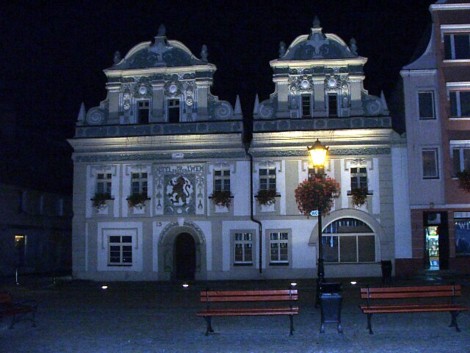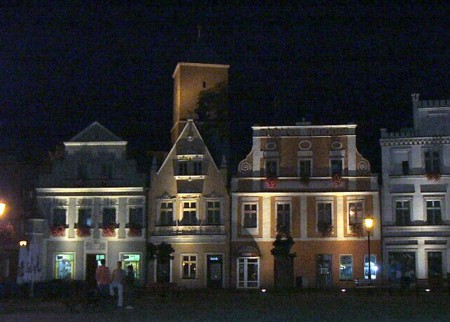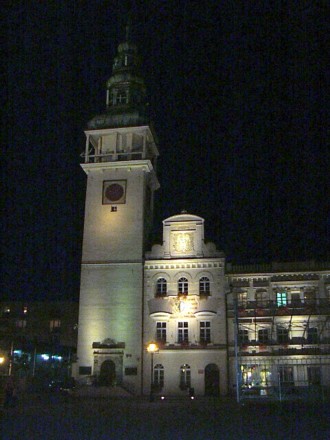Bytom Odrzański

Bytom Odrzański. Square. Hotel pod Zlotym Lwem. Night photo with facade lighting
Distance
Population
4.382 (2006)
Location and history
Bytom Odrzański is located in the eastern part of the Lubusz region (Nowa Sól District), on the left bank of the Odra River, 42 km southeast of the regional capital Zielona Góra.
The town's history probably dates back to the 11th century. Chronicle Gall Anonim, author of the oldest Polish medieval chronicle (in Latin), tells during the year 1109 that, during his attack on Poland, the German king (later emperor) Heinrich V had to abandon the considerable fortress Bytom by Odra. In the following centuries was Bytom’s history closely related to the tumultuous history of Lower Silesia. The city had to endure several tragic events such as floods, epidemics, fires and wars.
Under the German-Roman Emperor Friedrich I Barbarossa’s attack on Poland in 1157, Prince Bolesław IV Kędzierzawy at one time had to withdraw from the western territories, in which he burned the fortresses of Krosno Odrzańskie, Bytom Odrzański and Głogów. In 1289, the city was granted commercial property rights; at that time there were 3 city gates, namely at the exit roads towards respectively. Głogów, Szprotawa and Kożuchów; they were all demolished in the 19th century. A castle built in the late 13th century in the eastern part of the city burned in 1477. A monastery, dedicated to St. Magdalene, was erected in 1296, but in 1314 moved to Szprotawa. At the beginning and middle of the 14th century. the city was ravaged by a famine disaster, a grasshopper plague and the plague of the Black Death. After 1469 Bytom was no longer owned by a prince, but was in private hands. At the beginning of the 17th century, the first fixed bridge over Odra was erected. Between 1601 and 1628, one worked “Academic High School” in Bytom; It was a special type of educational institution with an academic purpose, more advanced than today's high school and just below the university level. In 1694, large parts of the city were destroyed by a fire. In the 19th century. was the Bytom center for a comprehensive production of wine. In 1945 – after 6 centuries under German rule – Bytom Odrzański returned to Poland.
In German times, the city was called Beuthen an der Oder.

Bytom Odrzański. Lot from the square. Night photo with facade lighting
Tourist attractions
The Old Town / Square
The inner city, especially the square, is beautifully restored. Around the square are beautiful Baroque and classicist style townhouses, while others represent a mix of styles. In large parts of the old town, including the entire square, extensive use of facade lighting has been made to highlight the buildings during the dark hours of the day.
City Hall (at the square)
The late Renaissance style town hall was built between 1602 and 1609.

Bytom Odrzański. City Hall viewed from the square. Night photo with facade lighting
Hotel pod Zlotym Lwem
Hotel Under the Golden Lion at the square was created by the connection of two houses mentioned as early as 1580. The building facade was renewed in Baroque style in the second half of the 17th century. A few years ago the building was renovated.
Saint Hieronymus’ Church
The church dates from the 14th century. In the facade wall are seen brick walls.
Borgerhuse
from the 18th and 19th centuries. on ul.Głogowska.
The moat
The remains of the city's medieval moat.
The oldest fortress
The remains of the oldest fortified settlement by Bytom Odrzański from the first Bolesław Krzywousty’s time was uncovered in 1961-62.
River terrace
The view terrace on the Odra River with summer café.
River dike
at Odra – a walking area.
Surrounding Area
There are 9 village units in Bytom municipality, each headed by a sołtys (village manager).
Wierzbnica . Of the villages around Bytom Odrzański, Wierzbnica is probably the oldest, mentioned in a document from 1175 (under the name Werbenice). At that time, the village had probably existed for half a century.
Accommodation
Booking.com
Bytom Odrzański (Town official page)
Eating Out:
Bytom Odrzański (Town official page)
Other Internet sites and sources
Bytom Odrzański (Town official page)
Translated into English by Google Translate. Spangshus.dk accept no liability for any errors or omissions in translation.
Map

Rating
Search
Most used tags
churches (205) Castles (86) Monasteries (79) Town walls (74) Lakes (71) Town halls (67) Rivers (65) Castles1 (62) Mansions (55) Museums (51) Regional museums (38) Town gates (36) Abbey churches (35) Castle ruins (30) Cathedrals (26) Forests (25) Health resorts (24) Water sports (23) Mounds (23) National parks (22)Click for all tags
Denne side er også tilgængelig på dansk. This page and contents is (c) Copyright 2018- www.spangshus.dk. Based on Inviator software by ISCA Software